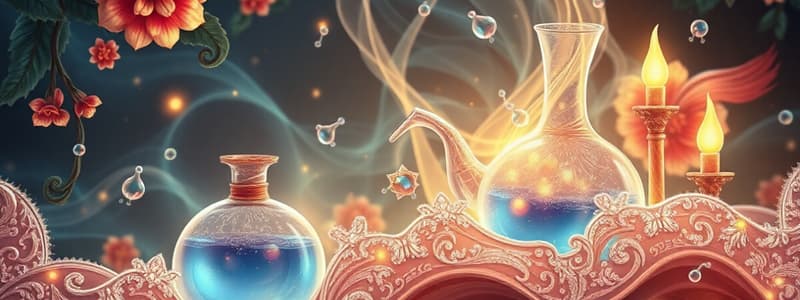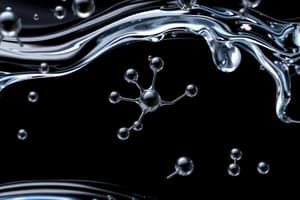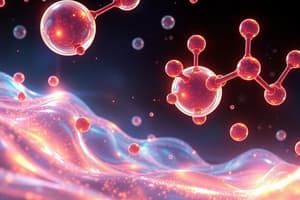Podcast
Questions and Answers
In a phase diagram, what information is represented along the Y-axis?
In a phase diagram, what information is represented along the Y-axis?
- Volume
- Density
- Pressure (correct)
- Temperature
Which type of intermolecular forces are the primary forces holding molecular crystals together?
Which type of intermolecular forces are the primary forces holding molecular crystals together?
- London Dispersion Forces and Hydrogen Bonds (correct)
- Metallic Bonds
- Ionic Bonds
- Covalent Network Bonds
What conditions of temperature and pressure typically favor the solid phase of a substance, according to a typical phase diagram?
What conditions of temperature and pressure typically favor the solid phase of a substance, according to a typical phase diagram?
- Low temperature and low pressure
- Low temperature and high pressure (correct)
- High temperature and low pressure
- High temperature and high pressure
What is a key characteristic of covalent crystals that distinguishes them from molecular crystals?
What is a key characteristic of covalent crystals that distinguishes them from molecular crystals?
Which characteristic is NOT typically associated with ionic crystals?
Which characteristic is NOT typically associated with ionic crystals?
What is the significance of the triple point on a phase diagram?
What is the significance of the triple point on a phase diagram?
Amorphous solids are also known as:
Amorphous solids are also known as:
Beyond the critical point on a phase diagram, a substance enters a state known as a supercritical fluid. What is a key characteristic of this state?
Beyond the critical point on a phase diagram, a substance enters a state known as a supercritical fluid. What is a key characteristic of this state?
A liquid with strong intermolecular forces would likely exhibit which of the following properties regarding vapor pressure?
A liquid with strong intermolecular forces would likely exhibit which of the following properties regarding vapor pressure?
Which of the following is NOT a typical characteristic of molecular crystals?
Which of the following is NOT a typical characteristic of molecular crystals?
Which type of solid is characterized by a well-defined order structure in three dimensions and a geometric shape resulting from net attractive intermolecular forces?
Which type of solid is characterized by a well-defined order structure in three dimensions and a geometric shape resulting from net attractive intermolecular forces?
How does the rate of evaporation compare to the rate of condensation in a closed system at equilibrium vapor pressure?
How does the rate of evaporation compare to the rate of condensation in a closed system at equilibrium vapor pressure?
Which statement correctly describes the electrical conductivity of covalent crystals?
Which statement correctly describes the electrical conductivity of covalent crystals?
What happens at the boundary line between the solid and gas phases in a phase diagram?
What happens at the boundary line between the solid and gas phases in a phase diagram?
What property of metallic crystals contributes most to their ability to conduct electricity?
What property of metallic crystals contributes most to their ability to conduct electricity?
Which scenario best describes a liquid with high surface tension?
Which scenario best describes a liquid with high surface tension?
Which characteristic distinguishes amorphous solids from crystalline solids?
Which characteristic distinguishes amorphous solids from crystalline solids?
A substance is observed to readily spread across a surface. What can be inferred about its surface tension and interaction with the surface?
A substance is observed to readily spread across a surface. What can be inferred about its surface tension and interaction with the surface?
How do surfactants affect the surface tension of a liquid, and what is the result of this change?
How do surfactants affect the surface tension of a liquid, and what is the result of this change?
Which transition occurs at the boundary between the liquid and gas phases on a typical phase diagram?
Which transition occurs at the boundary between the liquid and gas phases on a typical phase diagram?
If a substance is known to shatter irregularly and lacks a sharp melting point, what type of solid is it most likely to be?
If a substance is known to shatter irregularly and lacks a sharp melting point, what type of solid is it most likely to be?
What distinguishes crystalline solids from other types of solids?
What distinguishes crystalline solids from other types of solids?
Which property is characteristic of crystalline solids due to their highly ordered structure?
Which property is characteristic of crystalline solids due to their highly ordered structure?
If a newly synthesized material is described as rigid, incompressive, and possessing long-range order, it would most accurately be classified as which of the following?
If a newly synthesized material is described as rigid, incompressive, and possessing long-range order, it would most accurately be classified as which of the following?
Which of the following best explains the relationship between intermolecular forces (IMF) and the molar heat of vaporization?
Which of the following best explains the relationship between intermolecular forces (IMF) and the molar heat of vaporization?
A liquid forms a convex meniscus in a glass tube. What does this indicate about the adhesive and cohesive forces within the liquid?
A liquid forms a convex meniscus in a glass tube. What does this indicate about the adhesive and cohesive forces within the liquid?
How does an increase in temperature typically affect the viscosity of a liquid, and why?
How does an increase in temperature typically affect the viscosity of a liquid, and why?
A liquid has a high vapor pressure at room temperature. What can be inferred about its boiling point?
A liquid has a high vapor pressure at room temperature. What can be inferred about its boiling point?
Why do crystalline solids have a stable crystal structure?
Why do crystalline solids have a stable crystal structure?
What condition defines the normal boiling point of a liquid?
What condition defines the normal boiling point of a liquid?
How does the molar heat of vaporization relate to the energy required for a liquid to transition into a gas?
How does the molar heat of vaporization relate to the energy required for a liquid to transition into a gas?
What is the basic repeating unit in a crystalline solid called?
What is the basic repeating unit in a crystalline solid called?
Flashcards
Surface Tension
Surface Tension
Elastic force at a liquid's surface.
Surfactants
Surfactants
Substances that reduce surface tension, improving spreading.
Cohesive Forces
Cohesive Forces
Attraction between molecules in a liquid.
Adhesive Forces
Adhesive Forces
Signup and view all the flashcards
Vapor Pressure
Vapor Pressure
Signup and view all the flashcards
Equilibrium Vapor Pressure
Equilibrium Vapor Pressure
Signup and view all the flashcards
Crystalline Solids
Crystalline Solids
Signup and view all the flashcards
Properties of Crystalline Solids
Properties of Crystalline Solids
Signup and view all the flashcards
Meniscus Formation
Meniscus Formation
Signup and view all the flashcards
Viscosity
Viscosity
Signup and view all the flashcards
Molar Heat of Vaporization
Molar Heat of Vaporization
Signup and view all the flashcards
Boiling Point
Boiling Point
Signup and view all the flashcards
Unit Cell
Unit Cell
Signup and view all the flashcards
Lattice Points
Lattice Points
Signup and view all the flashcards
Amorphous Solid
Amorphous Solid
Signup and view all the flashcards
Phase Boundaries
Phase Boundaries
Signup and view all the flashcards
Solid-Gas Boundary
Solid-Gas Boundary
Signup and view all the flashcards
Solid-Liquid Boundary
Solid-Liquid Boundary
Signup and view all the flashcards
Liquid-Gas Boundary
Liquid-Gas Boundary
Signup and view all the flashcards
Ionic Crystals
Ionic Crystals
Signup and view all the flashcards
Metallic Crystals
Metallic Crystals
Signup and view all the flashcards
Phase Diagram
Phase Diagram
Signup and view all the flashcards
Triple Point
Triple Point
Signup and view all the flashcards
Critical Point
Critical Point
Signup and view all the flashcards
Solid Region
Solid Region
Signup and view all the flashcards
Molecular Crystals
Molecular Crystals
Signup and view all the flashcards
Intermolecular Forces (in Molecular Crystals)
Intermolecular Forces (in Molecular Crystals)
Signup and view all the flashcards
Covalent Crystals
Covalent Crystals
Signup and view all the flashcards
Study Notes
- The topic is the physical properties of liquids, intermolecular forces, and the distinctions between amorphous and crystalline solids.
Physical Properties of Liquids and Intermolecular Forces
- Surface tension measures the elastic force on a liquid's surface.
- Surfactants enhance spreading and penetrating properties by reducing surface tension.
Cohesive & Adhesive Forces
- Cohesive forces exist between molecules within a liquid leading to less attraction to other surfaces.
- Adhesive forces exist between molecules and the surface of another substance, resulting in greater attraction.
- Meniscus formation arises from cohesive and adhesive forces, forming either concave up or convex down shapes.
Viscosity
- Viscosity refers to a liquid's resistance to flow.
- Viscosity is inversely proportional to temperature and directly proportional to the strength of intermolecular forces (IMF).
- Viscosity is directly proportional to size and complexity.
- The SI unit for viscosity is pascal-second (Pa-s), with centipoise (cP) equal to 0.001 Pa-s.
Vapor Pressure
- Vapor pressure is the equilibrium pressure of a vapor above its liquid or solid state, where the evaporation rate equals the condensation rate.
- Molecules in vapor exert pressure by colliding with container walls.
- Equilibrium vapor pressure is exerted by gas and increases with high vapor pressure and temperature, where molecules, with enough kinetic energy, overcome IMF.
- Vapor pressure is inversely proportional to IMF, notably in dipole-dipole interactions.
- Stronger IMF is correlated with a greater amount of energy.
Molar Heat of Vaporization
- Molar heat of vaporization is the energy needed to vaporize one mole of liquid at a specific temperature.
- High intermolecular attraction necessitates high energy and heat of vaporization, as energy is required to free molecules from the liquid phase, measured at atmospheric pressure.
Boiling Point
- Boiling point occurs when vapor pressure equals external pressure.
- Normal boiling point is the temperature at which a liquid converts to gas at 1 atm.
- Higher evaporation rates result in higher boiling points.
Amorphous and Crystalline Solids
Classes of Solids
- Crystalline solids are composed of numerous small crystals with a definite geometrical shape and exhibit rigidity and incompressibility.
- Crystalline solids feature long-range order of particles in a repeated arrangement and are considered "true solids".
- Crystalline solids possess a definite heat of fusion and a sharp melting point, transitioning immediately to a liquid upon melting.
Properties of Crystalline Solids
- The unit cell is the basic repeating unit of crystalline solids.
- Atoms or molecules at lattice points are identically arranged.
- In most metals, lattice points are occupied by atoms.
- Crystalline solids often display a plane of symmetry in their structure.
- Crystal structures are stabilized by intermolecular forces and exhibit well-defined order in three dimensions, with geometric shapes reflecting attractive intermolecular forces.
Crystals
Ionic Crystals
- Composed of charged ions.
- Characterized by hardness and high melting points due to strong electrostatic forces.
- Poor electrical conductors in solid form but good conductors when melted.
- Subject to brittleness due to the breakage of attractive forces.
Metallic Crystals
- Held by electrostatic forces.
- Good conductors with high melting points.
- Lustrous, or shiny.
Molecular Crystals
- Have lattice points occupied by molecules.
- Intermolecular forces include London Dispersion forces and Hydrogen bond forces.
- Exhibit weak intermolecular forces.
Covalent Crystals
- Feature strong intermolecular forces.
- Poor electrical conductors.
- Can be made into one type of atom.
- Have very high melting points.
Amorphous Solids
- Amorphous solids lack well-defined shape and regular atomic arrangement.
- Amorphous solids behave as fake solids, pseudo-solids, or supercooled liquids.
- Amorphous solids can be molded and blown into various shapes, behaving like crystals at certain temperatures.
- Glass is the most versatile example of an amorphous solid.
- Amorphous solids shatter irregularly and lack sharp melting points, melting across a wide range of temperatures.
- Amorphous solids might contain impurities and exhibit weak intermolecular forces.
Phase Diagram
- Illustrates conditions under which a particular state is stable, physical states under different conditions of temperature and pressure, with the Y-axis representing pressure and the X-axis representing temperature.
Regions
- Solid phase occurs at low temperature and high pressure, found on the left side of the graph, indicating where phase changes start.
- Liquid phase occurs at moderate temperature and pressure, centrally located on the graph.
- Vapour/Gas phase occurs at high temperature and low pressure.
Boundaries
- At boundaries, a line represents a combination of pressure and temperature where phases beside each other are at equilibrium.
- The red/first line divides solid and gas phases, and the blue/last line divides liquid and solid.
- The red/first line indicates sublimation and deposition, the green/second line indicates melting and freezing.
- The blue/last line indicates evaporation and condensation.
Points
- A triple point represents both the temperature and pressure at which all three phases coexist in equilibrium.
- A critical point is where liquid and gaseous phases merge into a single supercritical fluid where liquid and gas are indistinguishable.
Studying That Suits You
Use AI to generate personalized quizzes and flashcards to suit your learning preferences.
Related Documents
Description
Explore liquids' physical properties, including surface tension, cohesive and adhesive forces, and viscosity. Understand the role of intermolecular forces. Learn the differences between amorphous and crystalline solids and their unique characteristics.




